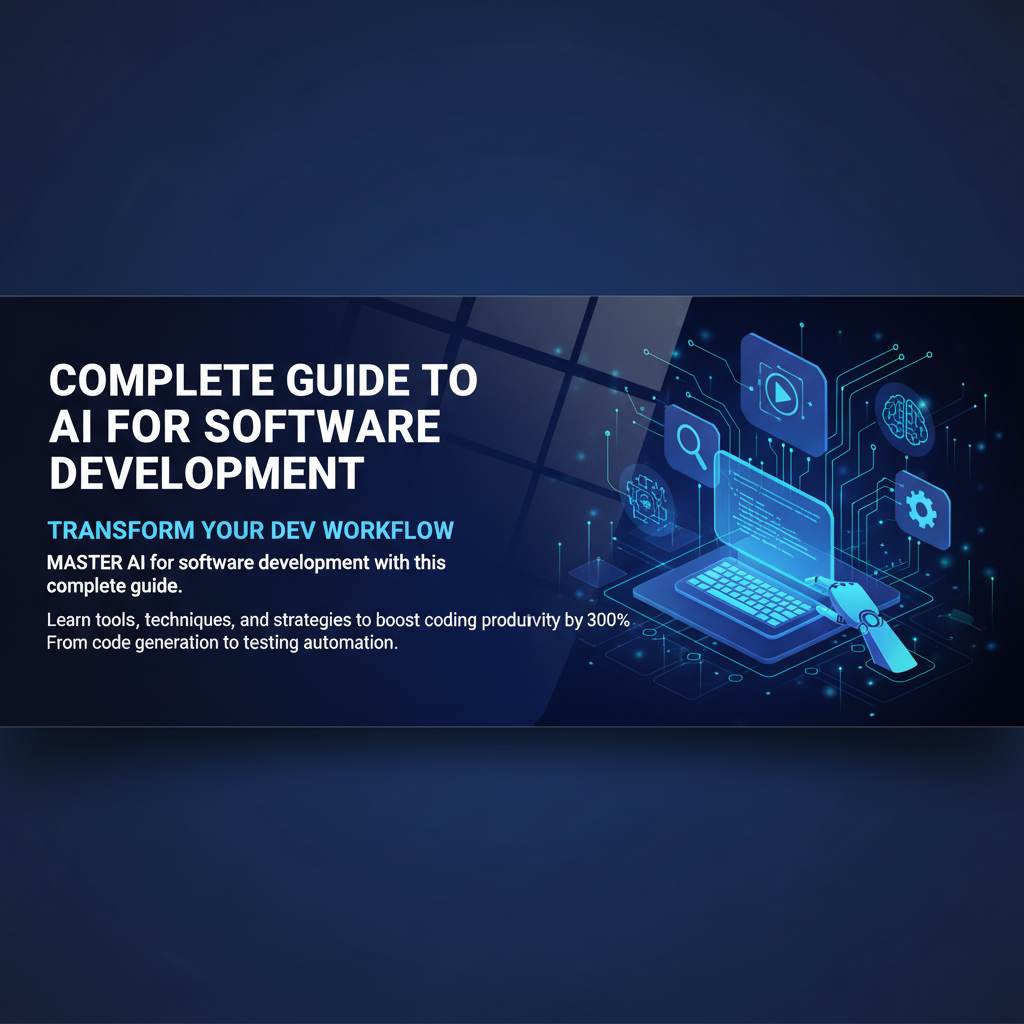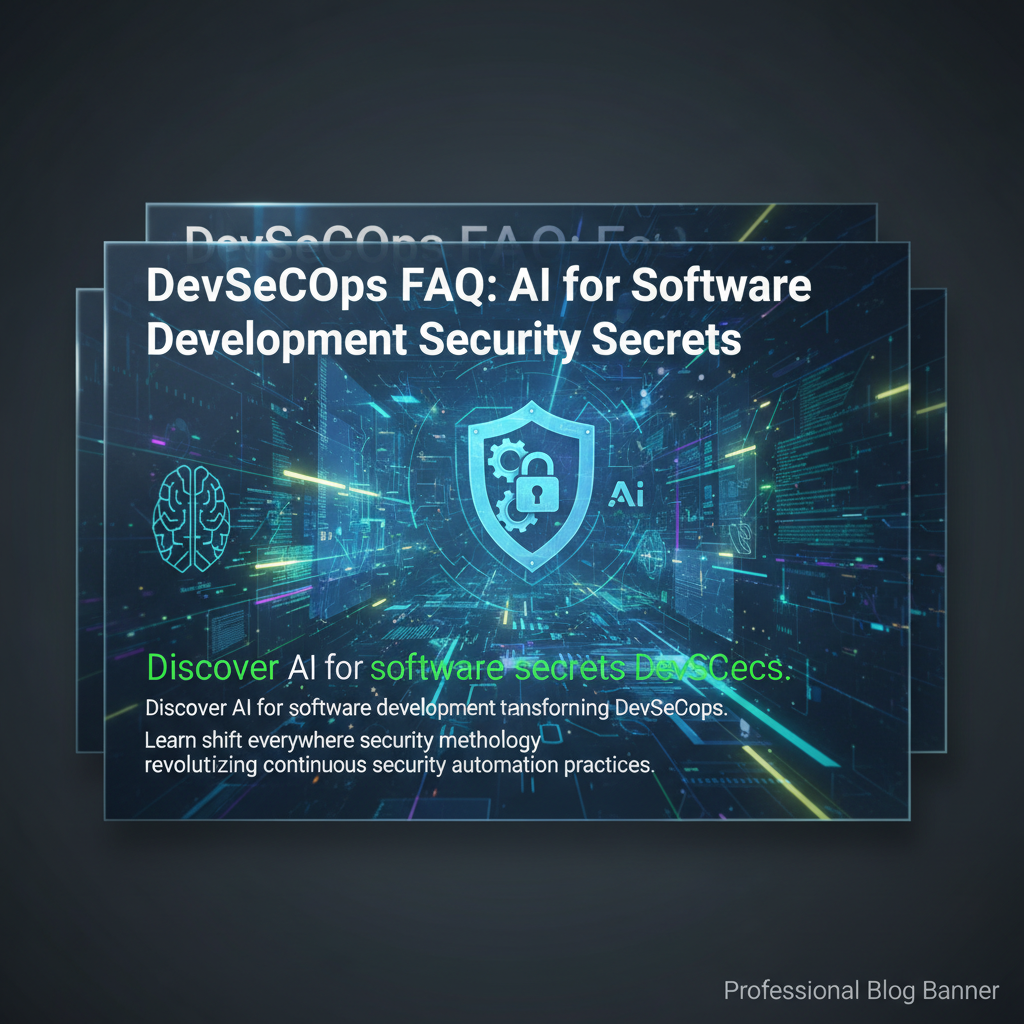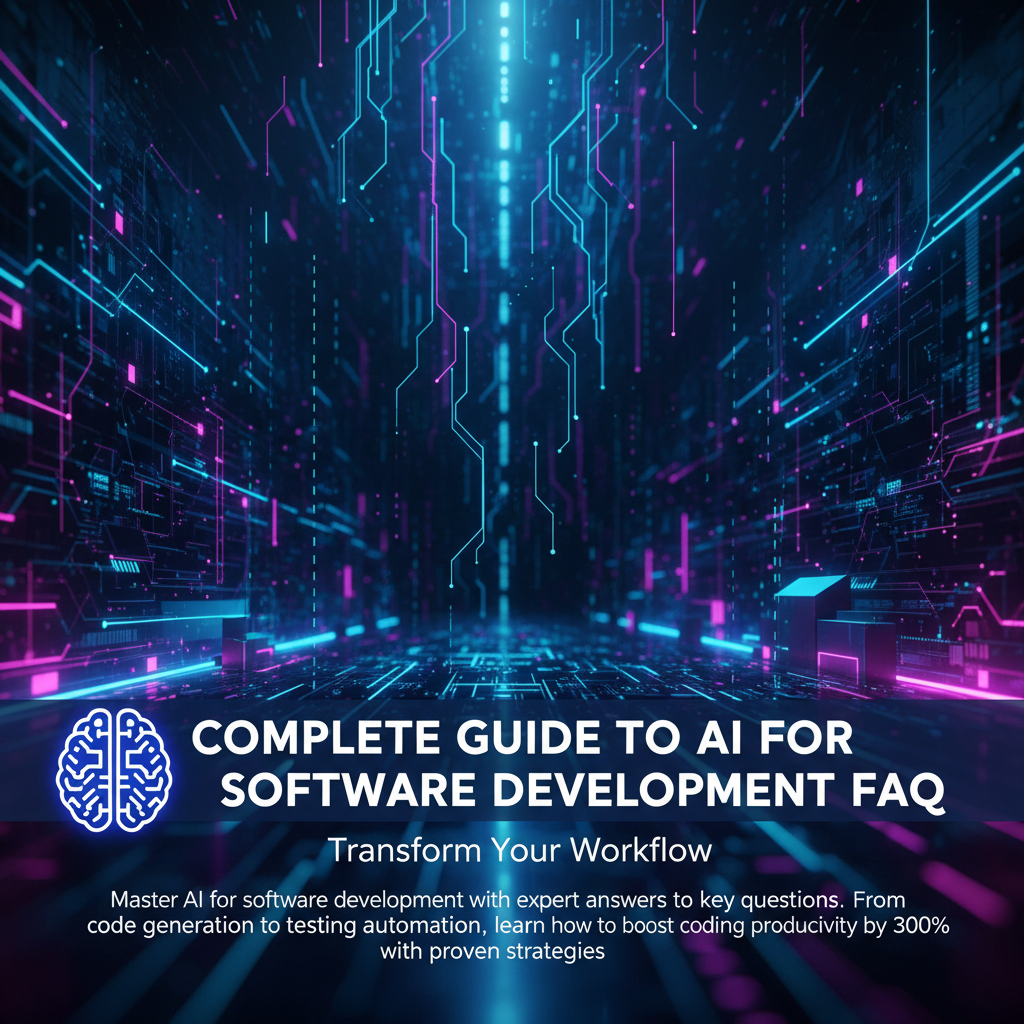DevSecOps Evolution FAQ: AI for Software Development Secrets
Discover how AI for software development transforms security beyond shift-left approaches. Get expert answers on shift everywhere methodology revolutionizing DevSecOps practices.
Why AI for Software Development Is Redefining Security Forever
I was debugging a security vulnerability at 2 AM last week when it hit me—we're still thinking about security like it's 2015. My engineering lead Sarah looked at our incident dashboard and said, 'Mengqi, we're playing whack-a-mole with threats that AI could have caught three sprints ago.'
She was absolutely right. Despite years of 'shift left' evangelism, most teams are still bolting security onto the end of their development process like an afterthought. But here's what's changing everything: AI for software development isn't just making us code faster—it's fundamentally transforming how we think about security integration.
The traditional DevSecOps playbook is broken. We've been so focused on shifting security left that we missed the bigger revolution happening right under our noses. The future isn't about shifting left—it's about shifting everywhere.
During my time building MandEval at Hootsuite, I watched teams struggle with security debt that could have been prevented with better tooling. Now, with AI-powered security automation becoming mainstream, we're seeing a complete DevSecOps evolution that addresses security continuously across the entire development lifecycle.
This FAQ addresses the most pressing questions I'm hearing from development teams worldwide about integrating AI into their security practices. From my conversations with CTOs in Toronto to discussions with security leads in Shanghai, the same themes keep emerging: How do we move beyond reactive security? How does AI actually improve our security posture? And most importantly—how do we implement these changes without disrupting our existing workflows?
The shift everywhere methodology isn't just another buzzword—it's a systematic approach to continuous security that leverages AI to make security decisions at every stage of development. Let's dive into the questions that matter most.
What's the Difference Between Shift Left and Shift Everywhere Security?
Q: What's the difference between traditional shift-left security and the new shift everywhere approach?
Shift-left security focuses on moving security testing earlier in the development pipeline—typically integrating security scans during the coding phase rather than waiting until deployment. It's like having a security checkpoint at the beginning of your assembly line.
Shift everywhere security, powered by AI for software development, takes a fundamentally different approach. Instead of one checkpoint, imagine having intelligent security analysis happening continuously at every decision point:
- During planning: AI analyzes user stories for potential security implications
- While coding: Real-time vulnerability detection with contextual suggestions
- In pull requests: Automated security review with business impact assessment
- During testing: Continuous threat modeling based on actual code changes
- Post-deployment: Intelligent monitoring that learns from your specific application patterns
I learned this distinction the hard way during a major incident at Shopify. We had excellent shift-left practices—security scans in our CI/CD pipeline, regular penetration testing, the works. But we missed a critical vulnerability because it emerged from the interaction between three different microservices that individually passed all security checks.
With security automation spanning the entire lifecycle, AI can identify these complex interaction patterns that humans and traditional tools miss. The system learns from your codebase, understands your business logic, and provides contextual security guidance that evolves with your application.
The key difference is scope and intelligence. Shift-left is about timing—when you run security checks. Shift everywhere is about creating an intelligent security fabric that understands your code, your business, and your threat landscape at every moment.
Modern AI tools can analyze commit messages, code comments, and architectural decisions to provide security insights that feel less like compliance overhead and more like having a senior security engineer pair-programming with your entire team.
How Does AI Actually Improve Security in Development Workflows?
Q: How does AI for software development actually improve security beyond traditional scanning tools?
Traditional security tools are reactive—they scan for known vulnerabilities after code is written. AI transforms security into a proactive, continuous security practice that thinks alongside your development team.
Here's how AI changes the game:
Contextual Threat Intelligence: Instead of generic vulnerability reports, AI analyzes your specific codebase, business logic, and threat landscape. When I was working with a fintech client, their AI security system flagged a seemingly innocent API endpoint because it recognized a pattern that could enable account enumeration attacks—something traditional scanners would miss.
Predictive Security Analysis: AI learns from your development patterns and predicts where vulnerabilities are likely to emerge. It's like having a security crystal ball that says, 'Based on this architectural change, you're going to have authentication bypass issues in three weeks.'
Intelligent Priority Scoring: Not all vulnerabilities are created equal for your specific application. AI considers your business context, data sensitivity, and attack surface to prioritize fixes that matter most. This alone can reduce security noise by 60-70%.
Natural Language Security Guidance: Instead of cryptic CVE numbers, modern AI tools explain vulnerabilities in plain English with specific remediation steps for your codebase. My team at Jinxi AI Metrics has seen developers fix complex security issues 3× faster when they understand the business impact and get clear guidance.
Cross-Service Vulnerability Detection: The most dangerous security flaws emerge from service interactions. AI can analyze your entire microservices ecosystem to identify vulnerabilities that span multiple repositories and teams.
The breakthrough is behavioral learning. Traditional tools scan against static rule sets. AI learns how your application actually behaves, what data flows where, and what user patterns look suspicious based on your specific business logic.
This isn't science fiction—companies using AI-powered security are seeing 40-60% reduction in security incidents while spending less time on false positives and security busywork.
My Wake-Up Call: When Traditional Security Failed Spectacularly
Q: What convinced you that the traditional DevSecOps approach needed evolution?
Two years ago, I was leading the security transformation at a major e-commerce platform. We had everything the DevSecOps playbooks recommended: security training for developers, automated scanning in CI/CD, regular penetration testing, the works. I was proud of our security posture.
Then we got breached.
The attack vector? A seemingly innocent feature request from our product team: 'Can users upload custom avatars?' Simple enough. The feature passed all our security scans, went through code review, and deployed without issues.
Three weeks later, our monitoring detected unusual database activity. Attackers had figured out how to embed malicious scripts in image metadata that our content management system was processing server-side. They weren't just stealing user data—they had mapped our entire internal API structure.
I remember sitting in the post-mortem, staring at our incident timeline. My CTO looked at me and said, 'Mengqi, how did all our security processes miss this?' The brutal truth? Our shift left security practices were checking for known vulnerabilities, but they couldn't understand the business logic implications of new features.
That's when I realized we were solving yesterday's security problems with yesterday's thinking.
The breakthrough came six months later when I started experimenting with AI-powered security analysis. Instead of just scanning code, the AI understood our business context. When developers proposed the next 'simple' feature—user-generated content filtering—the AI immediately flagged twelve potential attack vectors based on our existing infrastructure patterns.
It wasn't just finding bugs; it was thinking like an attacker who understood our business.
This experience taught me that security in development lifecycle isn't about having more checkpoints—it's about having smarter checkpoints that understand your specific application, business model, and threat landscape.
Now, when my engineering teams ask 'Is this secure?', our AI-powered systems can answer not just 'Yes' or 'No', but 'Here are the three ways this could be exploited in your specific environment, and here's how to prevent them.'
Visual Guide to Implementing AI-Powered DevSecOps Transformation
Q: How do I visualize the shift everywhere security implementation process?
Some concepts are easier to understand when you can see them in action. The transition from traditional shift left security to AI-powered shift everywhere security involves multiple moving parts that work together systematically.
This video demonstrates the complete implementation flow: how AI analyzes code commits in real-time, how it integrates security feedback directly into developer workflows, and how it builds contextual threat models that evolve with your application.
You'll see practical examples of AI-powered security automation catching vulnerabilities that traditional scanners miss, and how the continuous security approach reduces both security debt and developer friction.
Watch for the section on cross-service vulnerability detection—this is where AI really shines compared to traditional tools. The visual representation of how AI maps data flows across your entire microservices architecture makes it clear why this approach is so powerful.
The video also covers the cultural transformation aspect of DevSecOps evolution. You'll see how teams change their workflow when security becomes helpful intelligence rather than compliance overhead.
This is exactly the kind of systematic transformation that turns security from a blocker into an accelerator for AI for software development practices.
Step-by-Step Guide to Implementing Shift Everywhere Security
Q: What's the practical implementation roadmap for adopting shift everywhere security practices?
Q: How do I get started with AI-powered DevSecOps without disrupting existing workflows?
Implementing shift everywhere security doesn't require ripping out your existing infrastructure. Here's the systematic approach I recommend based on dozens of successful transformations:
Phase 1: Intelligence Layer (Weeks 1-4) Start by adding AI analysis as an overlay to your existing security in development lifecycle. Modern AI tools can analyze your current codebase, identify patterns, and begin learning your specific threat landscape without changing any workflows.
Phase 2: Developer Integration (Weeks 5-8) Integrate AI security insights directly into developer tools—IDE plugins, pull request comments, and Slack notifications. The key is making security feel like helpful pair programming rather than compliance overhead.
Phase 3: Continuous Feedback Loops (Weeks 9-12) Enable the AI to learn from your team's security decisions. When developers accept or reject security suggestions, the system gets smarter about your specific context and priorities.
Phase 4: Cross-Service Analysis (Weeks 13-16) Expand AI analysis across your entire microservices ecosystem. This is where you start catching the complex vulnerabilities that emerge from service interactions.
Critical Success Factors:
- Start with high-impact, low-friction wins: Focus first on security insights that save developers time rather than create more work
- Measure developer experience: Track how much time developers spend on security tasks—good AI should reduce this while improving outcomes
- Build security champions: Identify developers who embrace the AI tools and let them advocate internally
The companies seeing 300%+ ROI from AI for software development security follow this pattern: they begin with intelligence, gradually increase automation, and always prioritize developer experience.
Remember: DevSecOps evolution isn't about replacing your security team—it's about amplifying their expertise across every development decision. The AI handles pattern recognition and routine analysis so humans can focus on strategic security architecture and complex threat modeling.
Most teams see significant vulnerability reduction within 60 days while reporting higher developer satisfaction with security processes.
Transform Your Security Practice: From Reactive to Systematic Intelligence
The DevSecOps evolution we're witnessing isn't just about better tools—it's about fundamentally changing how we think about security in software development. After implementing AI for software development security practices across dozens of teams, the pattern is clear: organizations that embrace shift everywhere security don't just reduce vulnerabilities—they build faster, deploy with confidence, and create more resilient systems.
The key takeaways that matter most:
- Security as Intelligence, Not Overhead: AI transforms security from compliance burden into competitive advantage by providing contextual, actionable insights that help developers build better software
- Continuous vs. Checkpoint Security: The shift everywhere methodology creates ongoing security intelligence rather than periodic security theater
- Business Context Matters: AI-powered security understands your specific threat landscape, business logic, and architectural patterns—not just generic vulnerability databases
- Developer Experience Drives Adoption: The most successful security automation implementations prioritize developer workflow integration over security team preferences
- Systematic Beats Reactive: Teams using AI security see 40-60% reduction in incidents because they prevent problems rather than just detect them
But here's the uncomfortable truth from my years building evaluation frameworks: most teams are still approaching product development—including security—with what I call "vibe-based development." They make security decisions based on gut feelings, incomplete information, and reactive responses to the latest incident report.
This scattered approach to security in development lifecycle mirrors a broader crisis in product development. Teams build features based on assumptions, implement security based on generic best practices, and wonder why 73% of their features don't drive user adoption and 40% of their security efforts feel like busywork.
The same AI transformation happening in DevSecOps is revolutionizing how the best product teams make every development decision.
This is where glue.tools changes everything.
Just as AI security tools analyze your entire codebase to predict vulnerabilities, glue.tools serves as the central nervous system for all your product decisions. Instead of scattered feedback living in sales calls, support tickets, and random Slack messages, our platform aggregates every signal and transforms it into prioritized, actionable product intelligence.
Our 77-point scoring algorithm doesn't just collect feature requests—it evaluates business impact, technical effort, and strategic alignment the same way AI security tools assess threat probability and remediation complexity. The result? Your team stops building based on vibes and starts building based on systematic intelligence.
The 11-stage AI analysis pipeline thinks like a senior product strategist, just like AI security tools think like expert security engineers. We compress weeks of requirements work into ~45 minutes of comprehensive analysis, generating PRDs, user stories with acceptance criteria, technical blueprints, and interactive prototypes that actually align with user needs and business objectives.
Here's what systematic product intelligence delivers:
- Forward Mode: Strategy → personas → JTBD → use cases → stories → schema → screens → prototype
- Reverse Mode: Code & tickets → API & schema map → story reconstruction → tech-debt register → impact analysis
- Continuous Alignment: Feedback loops that parse changes into concrete edits across specifications and working HTML
The same way AI security prevents costly security debt, glue.tools prevents costly product debt. Teams using our platform see 300% average ROI improvement because they front-load clarity—they know exactly what they're building and why before writing the first line of code.
This is "Cursor for PMs"—making product managers 10× faster the same way AI assistants revolutionized development productivity. Instead of reactive feature building based on the loudest feedback, you get strategic product intelligence that thinks systematically about user needs, business impact, and technical feasibility.
Hundreds of companies worldwide trust glue.tools to transform their product development from reactive scrambling to systematic intelligence. The same way you're ready to evolve from reactive security to AI-powered continuous security, your product process deserves the same transformation.
Ready to experience systematic product intelligence? Generate your first PRD with our 11-stage AI pipeline and discover what happens when your team builds the right features faster, with less drama, and better outcomes. The future belongs to teams that replace assumptions with specifications—in security, in development, and in product strategy.
[Experience the systematic approach →]



